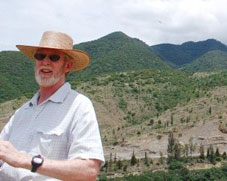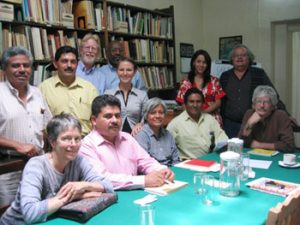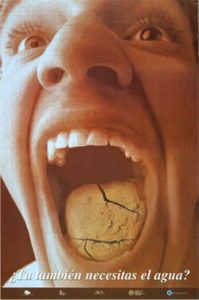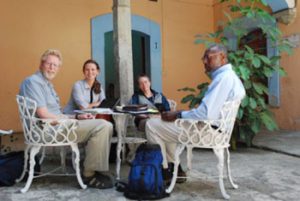It has been a much too busy week and a half here in Oaxaca. We arrived on Sunday night the 13th for what we hoped to be a full day of meetings with the head of the state water commission (CEA) and then a follow-up meeting with Sr Cajiga (the Finance Minister). On the up-side ½ of the agenda happened. We were not surprised as this is the way schedules and meetings go down here. Typically, you have a meeting scheduled with someone or something perceived as more important comes up and the original meeting is canceled. This happens all the time and you cannot take it personally (except that it shows you are lower on the priority list).
We came to Oaxaca specifically to meet with the head of CEA (Ruben), Adriana (from the finance minister’s office) and the Finance Minister Sr Cajiga. Our goal and purpose is to finalize and sign several contracts to help the state government analyze the health of many of their wastewater treatment systems and develop a framework and process for the Finance Minister’s office to follow when evaluating potential public works projects. In the month prior to this trip we had been talking with Adriana who is the head of investment for the Finance Minister. She helped us re-scope our proposals and arranged our meetings with the water commission and the finance minister.
Our flights were good and uneventful. We left Seattle at about 7am on Sunday 13 May and arrived safe in Oaxaca by about 10:30pm. Firdaus Jhabvala (Dr. J) had arrived about an hour earlier and was already checked into our regular hotel when we got there. It was late but we stretched our legs with a walk to the Zocalo while strategizing about our next few days in Oaxaca. Our first meeting was with Adriana at the INSO offices to formally meet her and prepare for the afternoon meeting with the state water commission. Adriana informed us that we would NOT be meeting with Sr Cajiga because he was called out of town. Thus, we knew the entire process would take much longer then she had planned.
Our first meeting with Sr Ruben (the head of the state water commission - CEA), went as we expected. He was not receptive to our proposal, as it would take work away from him and potentially change the way he does business. Dr J was GREAT as he called Ruben’s bluff and then Adriana jumped in and told him he needed to play by the Finance Minister’s ideas. We left the meeting agreeing we would meet again on Wednesday to hopefully come to an agreement. Adriana then treated us to a great lunch and we got a chance to socialize and talk some business.
We then got back to work modifying our proposal and budget to reflect the potential lack of support from CEA. This included enlarging the scope of work and including time and budget to train and gather all the background data that CEA says does not exist! We then met Adriana for breakfast on Wednesday morning. We went to a great café that is a coffee co-op and helps coffee farmers improve their crop and value. Adriana was very interested in the other work we are doing in Bravo Ahuja (rain harvesting) and our potential work with The Hunger Project. After talking about these projects for awhile we got down to business. I must first say we were the benefit of being more important. :) Adriana initially said she had to leave by 9am to attend another meeting. To our surprise she canceled it to stay with us.:) We spoke about our new scope of work and the increased budget. She was happy to hear our plan, and was not put off by the increase in the budget. The rest of the day we cleaned up the proposals and we found a mistake in the budget spreadsheet we were working on close to midnight the night before!
We all gathered at 6pm at the CEA offices just outside of town to have our second meeting with Sr Ruben. This one went better than the first as we think he was told he has to go along with our plan as proposed by Sr Cajiga. Still the meeting went for several hours until Sr Ruben agreed to our proposals. We left with Adriana tasked with trying to find and secure a meeting with Sr Cajiga. We knew this would take 3-5 days, but as it turns out it will be longer.
To help Adriana better understand exactly what we will provide, we took the CEA proposal and went line by line detailing the differences in our proposal and the CEA proposal. The CEA proposal was basically a plan to raise and rebuild 99 treatment plants without understanding if they are repairable or the root cause of failure. We have come to learn that CEA does not feel any responsibility for the failed plants and they are incentivized to build new ones vs fixing or developing a new process to ensure plants continue to work after they are built. Adriana was very happy to receive these reports, as this will help her in talking with Sr Cajiga.
Dr J left to return to home to Houston on Thursday morning. Adriana’s original idea about staying through midweek to finish up was much too optimistic. Since our last meeting, we have been trying to put the proposals in their final form with the latest changes and in the format expected by CEA and the Finance offices. We’re putting together our best guesses with the information that we have. We are on hold with Adriana and Sr Cajiga waiting until he is available to meet with us. Right now, we hope to meet with him on Tuesday 29 May, after we return from Mexico City (D.F.) from our meetings with The Hunger Project.
Around town the city is at the beginning of the annual teachers’ strike which blocks most of the streets surrounding and including the Zocalo. Nelly tells is this can go on for 3- 15 weeks! First, it is TOTALLY PEACEFUL and it is sort of a huge street party. Because there are teachers from all over the state, there are a lot of different craft vendors selling their wares. Next, there is lots of GREAT street food on almost every corner. The bummer is that the already bad traffic is even worse!
Our tickets to return to Seattle are for Wednesday 30 May. At this point Stan will return as scheduled and Rick will stay another week or two in the hope of finalizing the contracts and securing the advance so we can start working on these important projects.
Stay tuned for more exciting news ( as we have time to write about it) :)
Rick & Stan






















 Professor Rosendo Barragan Mendoza teaches grade 6 at Valentin Gomez Farias Elementary School located in the village. Prof. Mendoza said, "Sometimes when we run out of water jugs and children are still thirsty, they have to drink water from the tap and this causes many diseases." He tells us that clean filtered water would allow the school to stop buying expensive bottled water - and spend the money instead on school supplies.
Professor Rosendo Barragan Mendoza teaches grade 6 at Valentin Gomez Farias Elementary School located in the village. Prof. Mendoza said, "Sometimes when we run out of water jugs and children are still thirsty, they have to drink water from the tap and this causes many diseases." He tells us that clean filtered water would allow the school to stop buying expensive bottled water - and spend the money instead on school supplies. 





